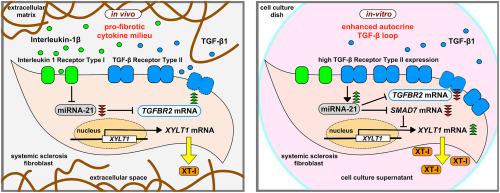Biochemical and Biophysical Research Communications ( IF 3.1 ) Pub Date : 2021-03-01 , DOI: 10.1016/j.bbrc.2021.02.092 Thanh-Diep Ly 1 , Anika Kleine 1 , Ricarda Plümers 1 , Bastian Fischer 1 , Vanessa Schmidt 1 , Doris Hendig 1 , Jörg H W Distler 2 , Joachim Kuhn 1 , Cornelius Knabbe 1 , Isabel Faust 1

|
Systemic sclerosis (SSc) is an inflammatory fibrotic disease characterized by an excessive extracellular matrix deposition in the skin and internal organs. One fibrotic key event remains the fibroblast-to-myofibroblast differentiation that is controlled by a combination of mechanical and soluble factors, such as transforming growth factor-β1 (TGF-β1) and interleukin-1β (IL-1β). One important myofibroblast biomarker is human xylosyltransferase-I (XT-I), the initial enzyme in proteoglycan biosynthesis. Increased serum XT activity was quantified in SSc, but the underlying cellular mechanisms remain elusive. This study aims to determine the cellular basis of XT-I induction in SSc by using a myofibroblast cell culture model with SSc fibroblasts (SScF) and healthy control fibroblasts. We found that SScF exhibit a higher extracellular XT-I activity compared to control fibroblasts. This increased XT-I activity in SScF was demonstrated to be mediated by an enhanced autocrine TGF-β signaling. Upon IL-1β treatment, SScF showed an increased mRNA expression level of XT-I and TGF-β receptor II (TGFBR2), while healthy control fibroblasts did not, pointing towards an involvement of IL-1β in the cytokine-mediated XT-I induction. Performing microRNA (miRNA) inhibition experiments in the presence of TGF-β1, we showed that the pro-fibrotic effect of IL-1β may be mediated by a miRNA-21/TGF-β receptor II axis, enhancing the autocrine TGF-β signaling in SScF. Taken together, this study improves the mechanistic understanding of fibrotic XT-I induction in SSc by identifying a hitherto unknown IL-1β-mediated miRNA-21/TGFBR2 regulation contributing to the enhanced XYLT1 expression and XT-I activity in SScF.
中文翻译:

系统性硬化症皮肤成纤维细胞中细胞因子介导的人木糖基转移酶-I诱导
系统性硬化症 (SSc) 是一种炎症性纤维化疾病,其特征是皮肤和内脏器官中细胞外基质过度沉积。一个纤维化的关键事件仍然是成纤维细胞向肌成纤维细胞的分化,它由机械和可溶性因子的组合控制,例如转化生长因子-β1 (TGF-β1) 和白细胞介素-1β (IL-1β)。一种重要的肌成纤维细胞生物标志物是人木糖基转移酶-I (XT-I),它是蛋白聚糖生物合成中的初始酶。在 SSc 中量化了增加的血清 XT 活性,但潜在的细胞机制仍然难以捉摸。本研究旨在通过使用具有 SSc 成纤维细胞 (SScF) 和健康对照成纤维细胞的肌成纤维细胞培养模型,确定 SSc 中 XT-I 诱导的细胞基础。我们发现与对照成纤维细胞相比,SScF 表现出更高的细胞外 XT-I 活性。SScF 中这种增加的 XT-I 活性被证明是由增强的自分泌 TGF-β 信号介导的。在 IL-1β 处理后,SScF 显示出 XT-I 和 TGF-β 受体 II 的 mRNA 表达水平增加。TGFBR2 ),而健康对照成纤维细胞没有,表明 IL-1β 参与细胞因子介导的 XT-1 诱导。在 TGF-β1 存在下进行 microRNA (miRNA) 抑制实验,我们发现 IL-1β 的促纤维化作用可能由 miRNA-21/TGF-β 受体 II 轴介导,增强自分泌 TGF-β 信号传导在 SScF。总之,这项研究通过鉴定一种迄今未知的 IL-1β 介导的 miRNA-21/ TGFBR2调节,促进了SScF 中 XYLT1表达和 XT-I 活性的增强,从而提高了对 SSc 中纤维化 XT-I 诱导的机制理解。






























 京公网安备 11010802027423号
京公网安备 11010802027423号